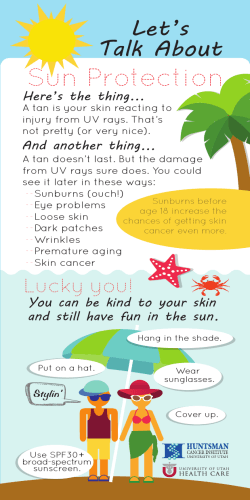
S F C ELECTING
211 West Wacker Drive Suite 1700 Chicago, Illinois 60606 1-800-331-2020 www.preventblindness.org SELECTING SUNGLASSES FOR CHILDREN The sun emits many types of rays, including visible light, which lets you see; infrared radiation, invisible but felt as heat; and ultraviolet (UV) radiation, also invisible and often called the “sunburn” ray. Mounting scientific evidence shows that exposure to UV rays can damage your eyes. The most immediate danger to children is photokeratitis, a painful type of corneal sunburn linked with the bright sunlight reflected off beaches and ski slopes. Long-term exposure can lead to cataracts (cloudiness of the lens), skin cancer around the eyelids and even macular degeneration. Prevent Blindness America recommends that everyone, including children, protect their eyes from the sun’s harmful rays. Sunglasses with UV protection can help boost the eyes’ ability to filter out the damaging rays. But if the sunwear doesn’t block UV rays, it may actually be more harmful to wear the sunglasses. Sunglasses without UV protection shade the eyes from the bright sun, but cause the pupils to dilate, actually allowing in more harmful rays. The following guidelines may help you select sunglasses that are safe and appropriate for your child. Shop for sunglasses that block 99% to 100% of both types of ultraviolet rays: UV-A and UV-B. Sunglasses should also eliminate glare and squinting. Be wary of labels that claim a product blocks harmful UV without specifying exactly what amount of UV rays they block. Look at the lenses carefully for scratches, bubbles and distortions. Here’s an easy test for non-prescription lenses: hold the glasses away from your eyes and look at a good horizontal or vertical line, such as a window frame. Look through the lenses and check if the line appears straight. If the line appears wavy, the glasses may actually make it more difficult to see (although some distortion Founded in 1908, Prevent Blindness America is the nation's leading volunteer eye health and safety organization dedicated to fighting blindness and saving sight. Focused on promoting a continuum of vision care, Prevent Blindness America touches the lives of millions of people each year through public and professional education, advocacy, certified vision screening training, community and patient service programs and research. may be seen with prescription lenses for corrective purposes). Flaws and distortion in the lenses may cause your child’s eyes to work harder and result in squinting, blinking, tearing and possibly even slight headaches. Check the sunglasses periodically to make sure they fit well and are not damaged. Children often don’t complain about their vision even when there is a problem. A regular check of their glasses is a good idea. Select sunglasses that suit children’s active lifestyles. The glasses should be impact resistant, lenses should not pop out of the frames, and the frames should be bendable, unbreakable and/or have snap-on temples. Check the label to ensure the lenses are made of polycarbonate, the most impact resistant material available. Children’s sunglasses should never be made of glass (unless required by their eye doctor). Polycarbonate lenses are the best choice for active children. Have the child try on the sunglasses before making a purchase. The lenses should be large enough to shield the eyes from most angles (above, below and either side) and to block light that enters in around the frames. The sunglasses should also fit snugly against the bridge of the child’s nose—again to reduce the amount of sunlight that enters the eyes. Choose a wide-brimmed hat for your child to maximize protection. The hat can cut the amount of UV exposure in half. The price for non-prescription sunglasses ranges from $2 to $50, or more for designer lenses. Fashion should be the last thing you think about when buying sunglasses. Look at the amount of UV protection, lens quality, and durability to assure that you buy the right sunglasses for your child. For more on UV Rays, Call the PBA Vision Health Resource Center at 1-800-331-2020. This publication is copyrighted. This sheet may be reproduced, unaltered, in hard print (photocopied) for educational purposes only. The Prevent Blindness America name, logo, telephone number and copyright information may not be omitted. Electronic reproduction, other reprint, excerption or use is not permitted without written consent. MK12 © 2005 Prevent Blindness America. All rights reserved.
© Copyright 2025





















